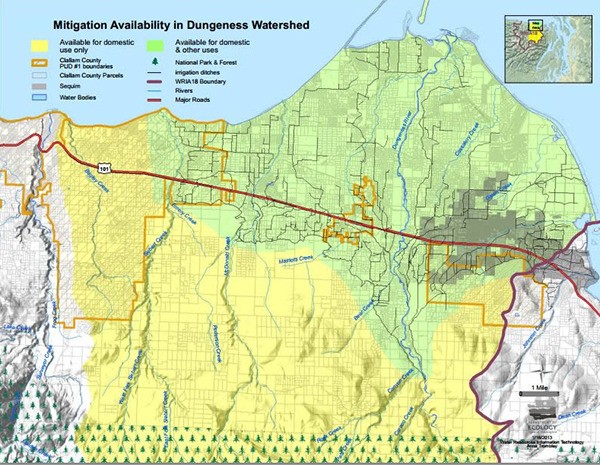The lack of snowpack in the Olympic Mountains may prove to be an obstacle for mitigation projects within the Dungeness Water Rule boundary.
Although the design for an aquifer recharge site located near Jake Way off Carlsborg Road is complete, it relies on increased river flow from snowmelt to be an effective water management strategy.
“The way it’s looking, I don’t know if we’ll have enough water available for aquifer recharge,” Joe Holtrop, Clallam Conservation District executive director, said.
The design concept for the recharge site entails an open trench, perforated pipe and drain rock.
Ideally, water from the Dungeness River would be captured and allowed to infiltrate into the ground, Holtrop explained, but with little snowpack and thus little runoff into the watershed, he isn’t sure if enough water will be available to divert mid-May through mid-July when he’d normally anticipate high river conditions.
Possible drought year
The Dungeness watershed is one of 62 watersheds Washington Department of Ecology officials oversees. Of the 62, it’s one of 40 watersheds DOE officials have red flagged for possible drought, Mike Gallagher, water resources section head for the Department of Ecology Southwest Regional, said.
“A drought can be declared when an area is experiencing or projected to experience a water supply that is below 75 percent of normal and water users within those areas will likely incur undue hardships as a result of the shortage,” Gallagher said. “The Dungeness is well below normal.”
Adding to the potential impact of an unusually warm winter, the Dungeness doesn’t have a reservoir, thus despite the significant rainfall received earlier in the year, it still leaves the area subject to water shortages, Gallagher explained.
In preparation to provide possible drought relief, DOE officials have submitted requests for drought relief emergency funding with the Legislature, but those funds have yet to be confirmed, Dan Partridge, communications manager for DOE’s Water Resources Program, said. If a drought is declared, relief funds could be used to encourage local irrigators not to grow a certain crop or possibly lease water from senior water right holders.
Push for more mitigation
Despite the looming snow inventory, County Commissioner Jim McEntire recently wrote to DOE officials seeking increased mitigation efforts within the confines of the Dungeness Water Rule stretching from Bagley Creek on the west to Bell Creek on the east.
“I want to make sure the rule works the way it was designed to,” McEntire said. “I want to urge DOE to be as specific as possible when it comes to mitigation.”
Most mitigation is being done on an individual property owner level, Gallagher said. Property owners are primarily choosing to purchase mitigation packages available through the Dungeness Water Exchange, acting like a water bank.
Property owners can submit their own mitigation design and plans for DOE approval, but Gallagher said they’ve yet to receive a plan.
Although DOE officials have yet to formally respond to McEntire’s letter, Gallagher said they’re aware of his requests and creating additional mitigation is a “goal” they “share with the county.”
To pursue this goal DOE officials are doing two things, Gallagher said — one, they’re welcoming local partnerships to explore ways to provide outdoor water to the southern area of the rule, and two, they’re working with Washington Department of Fish and Wildlife officials studying the need for restrictive water management in part to sensitive fish habitat. The WDFW official’s final report is expected late 2015 or early next year.
“We need to wait for the outcomes of that study,” Gallagher said. “But, in the meantime we’ll have broader discussion about additionally options … whatever those may be, like land use or deep well water supply.”
The Dungeness Water Rule, established by DOE officials, went into effect more than two years ago and has since limited new water users within thousands of acres in the southern portion of the rule area to indoor, domestic water use only.
“This has no doubt negatively affected both land use and potential land values for private landowners within this area,” McEntire wrote in his letter dated Jan. 27.
The Dungeness Water Rule, its impacts and the Carlsborg sewer system are the “hot topics” for his district and “both have a lot to do with water and the economy,” McEntire said.
The state Legislature earmarked $2 million from the state budget for water supply and streamflow mitigation purposes focused within the rule area (Water Resource Inventory Area 18) and should to be used before the next biennial budget takes effect July 1, McEntire explained.
“We’re near the end of the second year of the budget and I don’t want to assume those funds will still be available,” he said.
Gallagher said about $1.6 million already has been contracted out and the remaining money may go toward new mitigation efforts or toward existing projects in need of additional funds, but it’s unlikely it won’t be available after the next biennial budget.
A updated drought watch is available online at www.ecy.wa.gov/drought/index.html.
Reach Alana Linderoth at alinderoth@sequimgazette.com.


